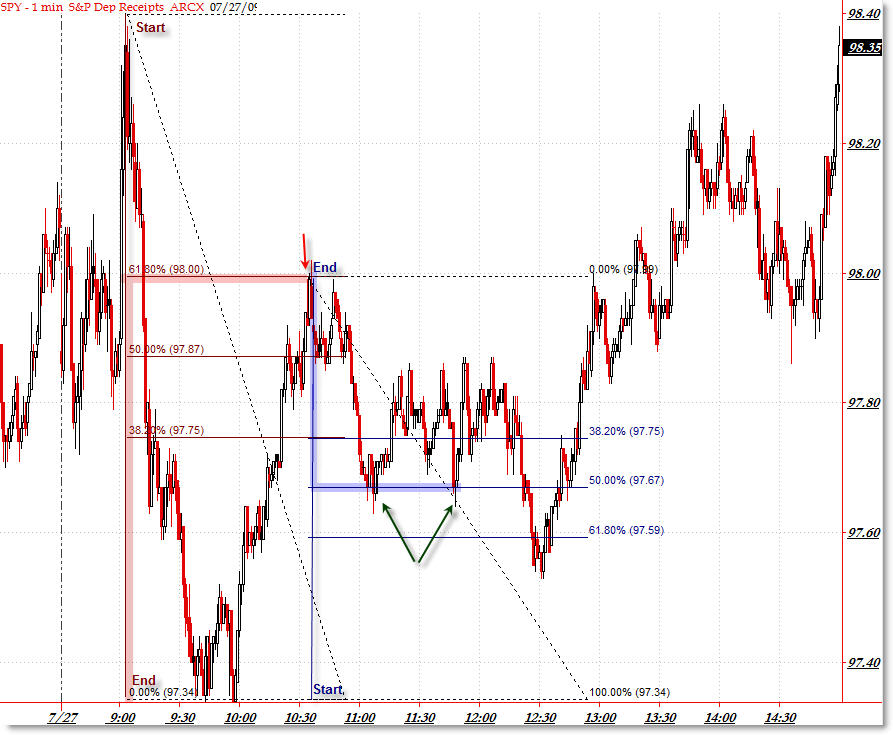Intraday Fibonacci Lessons July 27
The SPY (S&P 500) ETF gave as a few examples of how to use simple Fibonacci retracements for specific purposes of price targeting and trade entry. Let’s take a look at the chart to see what we can learn.
The full description and background for this lesson is in today’s “Teaching Moment” from the Idealized Trades Daily Subscription Service, but wanted to hit the highlights here.
When price made its initial large downswing from the $98.40 highs to the $97.34 lows, one could have entered long as price began to rise off the lows, breaking above the $97.50 highs off of a positive TICK divergence (not shown here) and doji on the 5-min chart.
How would you set your target? Or what price would you play for?
Drawing a specific Fibonacci Retracement grid from the highs to the lows could help answer that question.
First, let me say you would place a stop a slight distance – not too close but not to far – from the $97.34 swing lows.
The resulting 38.2%, 50.0%, and 61.8% Fibonacci retracements of the large morning down-swing come in at $97.75, $97.87, and $98.00 respectively – all of which could serve as logical price targets.
The 38.2% would be a conservative upside target; the 50.0% would serve as a moderate target, while the 61.8% would serve as an aggressive price target – your risk tolerance and trading tactics would determine what target to play for and how to size your position – that is for another post.
The 61.8% target would serve as a ‘maxmium’ or ‘best case scenario’ target (as observed when putting on the trade).
Notice how price retraced (rallied) all the way up to this level, found resistance as expected (blowing through the 38% and 50% retracements with ease… which gave clues that odds shifted further upside to come) and did retrace at the $98.00 zone (which corresponded with “Round-Number” confluence resistance).
Not only was this a trade exit (long) target, but it could have served as a ‘short-sale’ entry particularly since we formed an internal TICK divergence and bearish reversal candles (on the 5-min chart) at the $98.00 level.
The logic is the same on the second “Blue” Fibonacci grid I’ve drawn – only we’re looking for where the price will likely find support and thus a target (exit) to cover our short sale.
For a full, 2-page “Teaching Moment” description of this concept (wonderful example today) as well as a description of the various TICK Divergences and trading opportunities on the day – including how to recognize odds favored a Range Day developing (what to watch) and what strategies to use, please continue reading the day’s description in the “Idealized Trades” report.
Each day, I walk you through the price action, sharing ‘teaching moments’ like this as I see examples and describing how opportunities develop that form entries, targets, and stop-loss placement. The more you learn and see these concepts and have them shown to you, the better you’ll be in real time (in the heat of battle!) to recognize opportunities and manage the trades as they develop.
Corey Rosenbloom, CMT


nice post, corey
Nice example.
With price expanding in a clean five wave pattern, the SPY looks like it's setting up for a double top and a repeat of yesterday's opening drop.
Nice example.
With price expanding in a clean five wave pattern, the SPY looks like it's setting up for a double top and a repeat of yesterday's opening drop.